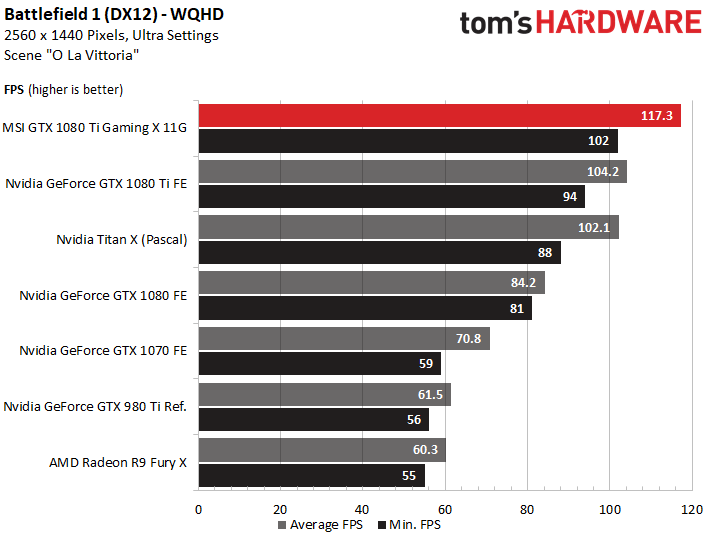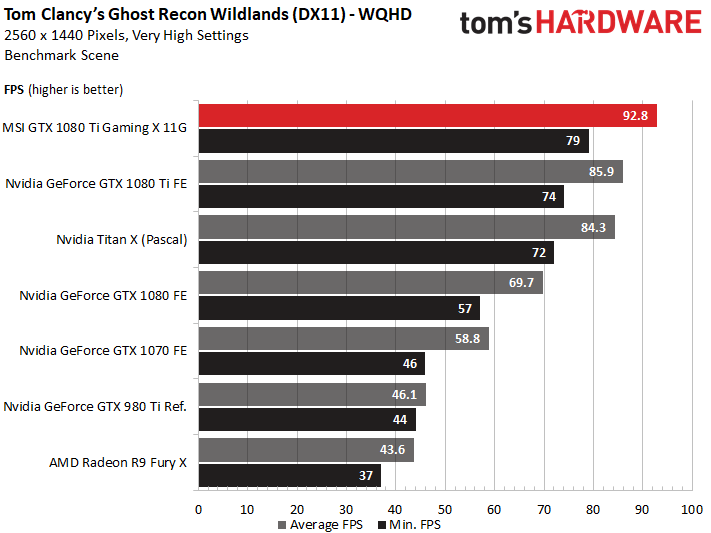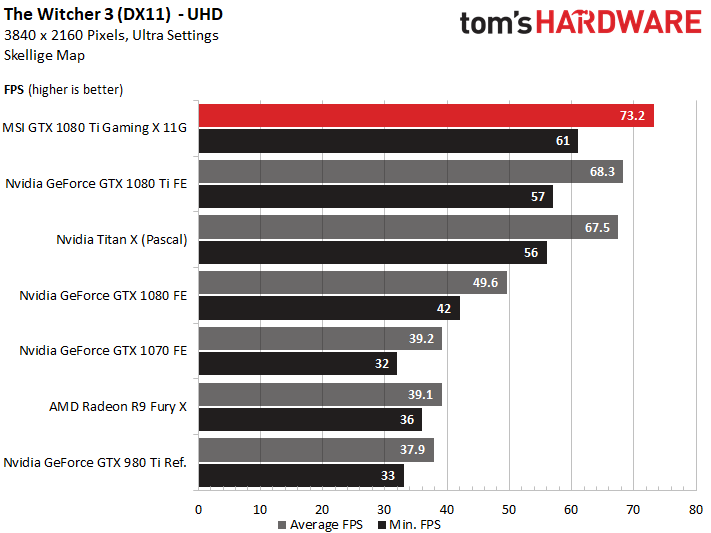MSI GeForce GTX 1080 Ti Gaming X 11G Review
Why you can trust Tom's Hardware
Gaming Performance
2560x1440 Results
There's no reason to test a GeForce GTX 1080 Ti at 1920x1080; at that resolution, even our high-end host processor bottlenecks performance. Rather, these cards are designed for 2560x1440 and up.






At QHD, MSI's GeForce GTX 1080 Ti Gaming X 11G is, depending on the game, between eight and 10 percent faster than Nvidia's GeForce GTX 1080 Ti Founders Edition or the Titan X (Pascal).
3840x2160 Results
At this high resolution, MSI's GeForce GTX 1080 Ti Gaming X 11G is between seven and nine percent faster than the GeForce GTX 1080 Ti Founders Edition and Titan X (Pascal) cards.






Many of these titles are playable at 4K. Those that aren't can be made smoother by dialing down the quality settings somewhat.
MORE: Best Graphics Cards
MORE: Desktop GPU Performance Hierarchy Table
MORE: All Graphics Content
Get Tom's Hardware's best news and in-depth reviews, straight to your inbox.

Igor Wallossek wrote a wide variety of hardware articles for Tom's Hardware, with a strong focus on technical analysis and in-depth reviews. His contributions have spanned a broad spectrum of PC components, including GPUs, CPUs, workstations, and PC builds. His insightful articles provide readers with detailed knowledge to make informed decisions in the ever-evolving tech landscape
-
Scorpionking20 Thanks. I would love a database of clocks/temps/noise comparing differing cards. I'm looking to sidegrade my 1070's to a 1080ti, and am not in a rush. Noise bugs me a lot more than others, so I try to go for the most quiet solution...but I may be getting a Ryzen with a proper loop too, so if I did that I may get a FE card to throw into the loop...too many options.Reply -
FormatC I've already tested four cards in Germany (four more in pipeline), all other stuff is already in translation. After publishing a few more cards on US site, we will put also a kind of landing/summary page with comparable data ;)Reply
But I can't spoiler the other reviews results before publishing it ;) -
zthomas Sound and temp is it increased with this card? .. with its own cooler how much cooler? Lots of fans pushing air.. yeah I updated my case.. has three large fans.. one thing i don't get.. I have seen nothing of temperature controls, no meters nothing to indicate temperatures inside the case.. or nothing showing use a peak times during gaming..Reply -
FormatC I can't understand your question, sorry.Reply
But you can monitor the GPU temperature by yourself with tools like GPU-Z or MSI Afterburner (also with an OSD). Then compare the results with my IR pictures and you have a good point to calculate the other temps by yourself. ;) -
FormatC The problem is:Reply
Nvidia has never sampled this card.
I have here a Quadro P6000 and this card is similar. Due the thermal limits of Nvidias stock cooler it is not significant faster. Ok, a little bit, but not a whole universe. And Nvidia will not be amused, if I use a 5000 USD workstation card in gaming benchmarks ;) -
LwNickV I have a question about Overclocking, you mention you need to "max out the voltage slider". But i saw it mentioned in another review that Voltage Slider is locked for this card. So what do you mean with that statement? Is just upping the Power Target to 330 enough to reach 2000 mhz+-?Reply -
Sam Hain Reply19669306 said:I have a question about Overclocking, you mention you need to "max out the voltage slider". But i saw it mentioned in another review that Voltage Slider is locked for this card. So what do you mean with that statement? Is just upping the Power Target to 330 enough to reach 2000 mhz+-?
Tom's was given an unlocked version of MSI AB back in March to test an FE Ti with it and was done using H20 cooling; http://www.tomshardware.com/reviews/geforce-gtx-1080-ti-water-cooling,4975-2.html They also give instructions on how to manipulate AB to access the voltage settings, until a new(er), unlocked version of AB rolls...
"We're fortunate enough to have a version of MSI’s Afterburner utility unlocked especially for us. If you want access to similar settings before a new version of Afterburner is released, you can manually add your 1080 Ti to the third-party database using the VDDC_Generic_Detection entry under the VEN_10DE&DEV_1B06&SUBSYS_120F10DE&REV_?? key. A quick search online should turn up plenty of in-depth instructions on how to do this."
However, you can just move the POWER-LIMIT slider to the max, along with bumping your clock settings. These aftermarket cards will crack past 2K MHz, no problem w/out touching voltage, this card included... It's a CHAMP!